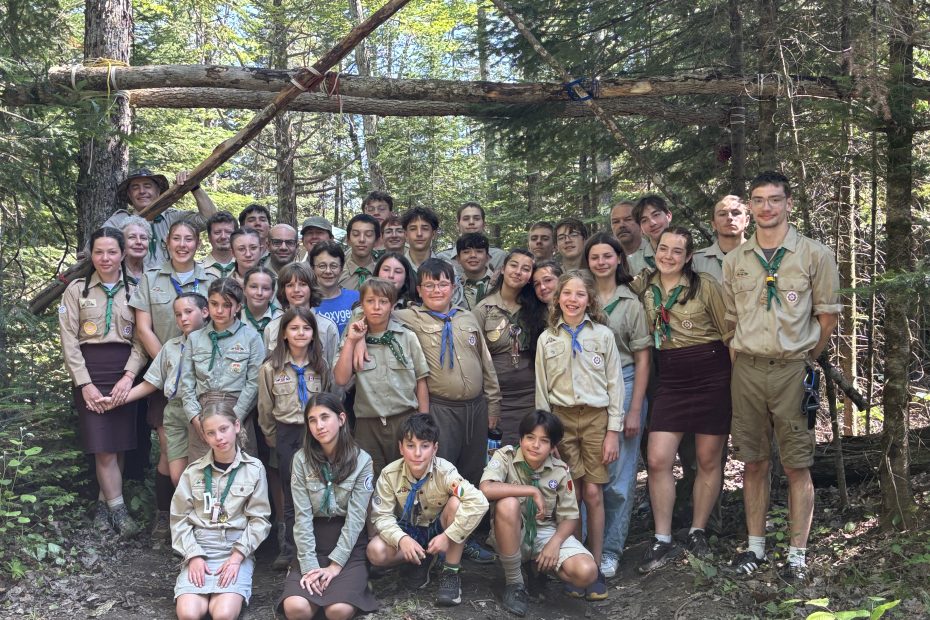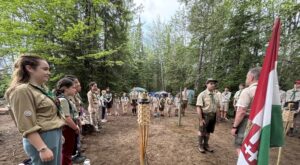Based on more than 61,000 votes cast, the Zsófia Viewpoint in Lillafüred came in second, and the Cuha Valley came in third.Continue reading

Three Hungarian scout troops based in the Canadian diaspora — No. 28 Ferenc Kölcsey, No 23. Saint Ladislaus, and No. 37 Saint Margaret — each named after Hungarian historic figures came together for a joint summer camp from June 28 to July 5, 2025, reported András Dobai on kanadaimagyardiaszpora.com.
It took place at Awakamenj Mino, a scenic site north of Ottawa on the Québec side, a familiar venue that had hosted several joint camps in the past.
This year, the location was especially idyllic, with scouts pitching their tents right on the lakeshore, setting the stage for a camp rich in water activities and outdoor exploration.
A total of 44 participants, from young, cub scouts to rover and ranger scouts, participated in this year’s camp. Thanks to the experienced leadership team and the support of parents, the camp was a success despite logistical challenges—such as the lack of running water and the need to bring all drinking water in bottles.
The first few days were spent building camp areas, refreshing scouting skills, and getting to know one another. During this time, according to the camp’s official story, the freshly “settled” Hungarians learned about the adventurous exploits of other tribes, reenacted through legendary characters like Árpád, Svatopluk of Moravia, and mythological hero, Botond.
On the camp’s second day, Father Matthew, the priest of the Hungarian Catholic Community of Ottawa, visited the campers in order to celebrate Mass together. Other special guests included Tamás Kontra, commander of the Eastern Canada Scout District, who joined the camp for a few days.
On July 1, the scouts were invited to a joint campfire by the central organization to celebrate Canada Day with French-Canadian scout troops.
While translating terms like zubbony (tunic) or töklepény (pumpkin pie) into French proved challenging, the spirit of the Hungarian campfire shone through.
In return, the Hungarian scouts learned about French-Canadian songs and food traditions—although, regrettably, there was no chimney cake left to share.
Physical challenges were also on the agenda, with canoe races, arm wrestling, and matches preparing the scouts for their own adventures. But they were soon interrupted by urgent news: a German army was preparing to attack the Magyars near Pressburg (modern day Bratislava). The scouts rallied and successfully repelled the enemy across water, land, and even in a nighttime battle using glow-in-the-dark numbers. Each scout patrol documented their heroic tales in original legends performed around the final campfire.

Scouts enjoying the camp in nature. Photo: Külföldi Magyar Cserkészszövetség Facebook
The camp ended on a bittersweet note: the inevitable sadness of taking down the tents was tempered by celebration. Five scouts were officially inaugurated as rovers on the final night, receiving their gray neckerchiefs—a symbol of commitment to scouting values in adulthood. Outstanding scouts and patrol leaders were recognized with awards, and the coveted “Best Patrol” medal went to the Csodaszarvas (Miraculous Deer) patrol.
All in all, it was a highly successful camp—one that left lasting memories for the scouts and rekindled a nostalgic sense of community for the leaders. The hope is that the experience will motivate all three troops for the coming scouting year—and that next summer, they’ll be back to camp together once again.
Via kanadaimagyardiaszpora.com; Featured image: Külföldi Magyar Cserkészszövetség Facebook